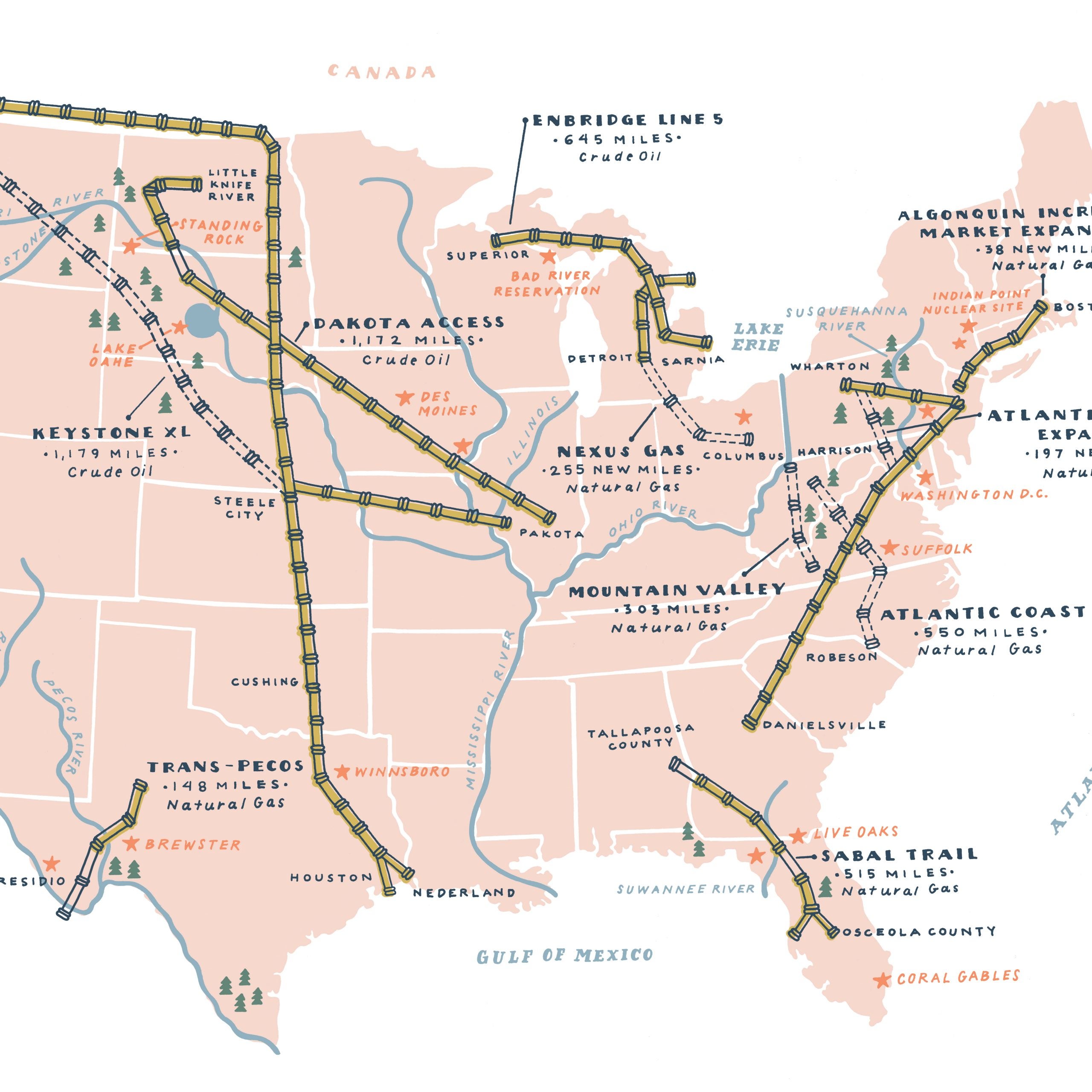Standing Rock, a once little known reservation on the border of North and South Dakota, became the focal point of national controversy this year when thousands of activists joined Native Americans to protest the environmental impacts of the Dakota Access oil pipeline. If completed, activists argue, the pipeline would impact sites sacred to the Standing Rock Sioux Tribe, cut through environmentally sensitive areas, and, if it were to leak, contaminate drinking water downstream in the Missouri River.
Standing Rock isn’t the only place where our country’s appetite for cheap energy is being openly opposed. While protesters have been evicted and construction resumes on Dakota Access, the fight rages on across the country where demonstrators are fighting similar pipeline projects.��Protests have erupted in Texas, Florida, West Virginia, Wisconsin, and Ohio, among other states, where more than a dozen proposed oil and natural gas projects look to expand the country’s roughly 2.5 million-mile pipeline infrastructure.
In an effort to shed light on some of these projects, and the possible environmental consequences attached to each, we mapped out nine other noteworthy projects currently under protest. Below, we’ve detailed each one and what may be at risk if they are to be built.
Trans-Pecos Pipeline (Natural Gas)
Location: Southwest Texas, near Big Bend National Park
Length: 148 miles
Status: 98 percent complete
Overview: Operated by Energy Transfer Partners in Dallas (the same corporation behind DAPL), this pipeline—the first in the Big Bend region of Texas—will bring natural gas across the Rio Grande River into Mexico. Protesters continue to fight this project in places like Brewster County, Texas, where seven people were arrested in February. Native Americans have also the pipeline’s effect on indigenous sites in West Texas.��
Mountain Valley Pipeline (Natural Gas)
Location: West Virginia, Virginia
Length: 303 miles
Status: �ʰ��DZ�Dz������
Overview: Proposed by Mountain Valley Pipeline LLC, this project would bring natural gas from northwestern West Virginia to southern Virginia. This pipeline is slated to cross the Appalachian Trail in the Jefferson National Forest, and the Appalachian Trail Conservancy is leading the fight against the proposal.��
Sabal Trail Pipeline (Natural Gas)
Location: Alabama, Georgia, Florida
Length: 515 miles
Status: 80 percent complete
Overview: Operated by Sabal Trail Transmission LLC, this project will bring natural gas from Tallapoosa County, Alabama, through Georgia to Osceola County, Florida. Protests have flared up in places like Live Oak, Florida, near the banks of the Suwannee River, where . Protests recently resulted in 18 arrests and a halt to construction.��
Atlantic Sunrise Expansion (Natural Gas)
Location: �ʱ�ԲԲ���������Ծ�����
Length: 197.7 miles of new pipeline
Status: �ʰ��DZ�Dz������
Overview: Proposed by Oklahoma-based Williams Partners, this project would expand the roughly 10,000-mile Transco Pipeline System. Protesters began in Pennsylvania in fall 2016, most recently in Lancaster County. Protesters also and say that they plan to disrupt construction.��
Atlantic Coast Pipeline (Natural Gas)
Location: West Virginia, Virginia, North Carolina
Length: 550 miles
Status: �ʰ��DZ�Dz������
Overview: Proposed by a consortium of utility companies, this pipeline brings natural gas from Harrison County, West Virginia to parts of Virginia and North Carolina. Opposition has ramped up recently, particularly in communities like Suffolk, Virginia, where in February, voicing concerns about environmental disruption and contamination of drinking water in the Chesapeake Bay Area.��
Nexus Gas Transmission (Natural Gas)
Location: Ohio, Michigan, Ontario
Length: 255 miles of new pipeline
Status: �ʰ��DZ�Dz������
Overview: Proposed by Spectra Energy, this project would bring natural gas from Ohio to Michigan and Ontario, Canada. Protesters have raised concerns that clear-cutting for the project could in Northeast Ohio. City planners in communities along the proposed route have argued that the pipeline would stifle development. And researches have claimed that Northeast Ohio is to withstand the pipeline construction.��
Enbridge Line 5 (Crude Oil)
Location: Michigan, Wisconsin, Ontario
Length: 645 miles
Status: ��DzԲ��ٰ��ܳ��ٱ����
Overview: Line 5, owned and operated by Enbridge, has been in operation since 1953, bringing crude oil from Superior, Wisconsin through Michigan’s Upper and Lower Peninsulas to Ontario, Canada. The pipeline crosses the Bad River Native American Reservation in Odanah, Wisconsin and the tribe not to renew the pipeline’s right-of-way through tribal lands in January. More recently, hundreds of protesters concerned about the Great Lakes’ water quality .��
Algonquin Incremental Expansion (Natural Gas)
Location: New York, Connecticut, Rhode Island, Massachusetts
Length: 38 miles of new pipeline
Status: Under construction
Overview: Operated by Spectra Energy, this expansion would join the 1,129-mile Algonquin Pipeline system that runs from New York to Massachusetts, supplying the Northeast with natural gas. The expansion is replacing much of the 26-inch diameter pipeline with a 42-inch line. The expansion would add 38 new miles to the system and in New York, which has been a source of major protest.��
Keystone XL Expansion (Crude Oil)
Location: Canada, Montana, South Dakota, Nebraska
Length: 1,179 miles of new pipeline
Status: Proposed (and resurrected)
Overview: This expansion to the existing Keystone Pipeline system—bringing crude oil from Alberta to Steele City, Nebraska—was originally proposed in 2008, but in November 2015 the the project. A section running south from Cushing, Oklahoma to the Gulf opened in January 2014, but President Obama never approved the northern stretch of the line. The expansion was revived on January 24 by President Trump, across the country in places like Los Angeles, New York, Seattle, and Washington, D.C..��


